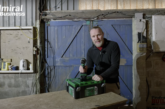Roger Bisby gets his fill with EcoTherm
![]() There are now any number of online calculators for working out the U Values of building materials in conjunction with insulation. I recommend EcoTherm’s because it is very easy to use and doesn’t require a log in or registration. By changing the type of construction, or type of insulation you can see immediately in the top right hand corner just how much you can improve the U Value.
There are now any number of online calculators for working out the U Values of building materials in conjunction with insulation. I recommend EcoTherm’s because it is very easy to use and doesn’t require a log in or registration. By changing the type of construction, or type of insulation you can see immediately in the top right hand corner just how much you can improve the U Value.
I started using on line calculators because customers were always trying to find ways of improving the SAPS – not so they could lower their bills, or save the planet, but because they wanted to trade off savings so they could increase the amount of glazed area they were allowed under the Building Regulations. You can blame it on Grand Designs but the old maximum of 25 per cent of the floor area for your glazing has gone out of the window.
So, once you have taken the drawing, and changed a few things, such as cavity widths and masonry, the next thing to look at it what you put in that cavity. On this particular extension the architect had specified 50mm PIR board partial fill which, together with a turbo block, gave us 0.26, which is nicely within the recommended 0.28, but I found that by changing to EcoTherm’s 90mm T&G Full Fill board I could achieve 0.18 which is a big improvement.
One thing that does puzzle some people, however, is how a 90mm board in a 100mm cavity can be described as ‘Full Fill’. You might think that it is all about providing a bit of room for the brickie, which is a consideration, but it is really more about maintaining an air gap so the low emissivity foil face can reflect back any heat transfer across the air space. The air space is actually more efficient than filling it.
Now it has to be said there are bricklayers who are nervous about full fill because it means they have to work cleaner and not drop snots over the tops of the board tongues when they bring up the inner skin. One thing that works well is to lay some plywood over the insulation boards as you are bringing the inner skin up. You can slide this board along and clean off the inner leaf as you go so the board sits neatly back against the inner block. Once you get used to it is really quite a nice way to work. That said my brickies were not happy about putting the boards in before the mortar had a chance to go off because the said it disturbs the wall ties and makes them loose.
![]()
Their preferred method was to bring the inner skin up first. This is generally not considered good practice because wind loads can destabilise the wall and break the mortar bond or blow it over. However, in our case we were using concrete blocks so the outer skin was brought up within the same day as the inner skin. So the conclusion is that if you are building with brick you need to bring both leaves up together, but bricks being more time consuming means that the blocks will be firming up nicely by the time you get to slipping the boards in under the ties.
Click here to use EcoTherm’s online calculator for yourself.








